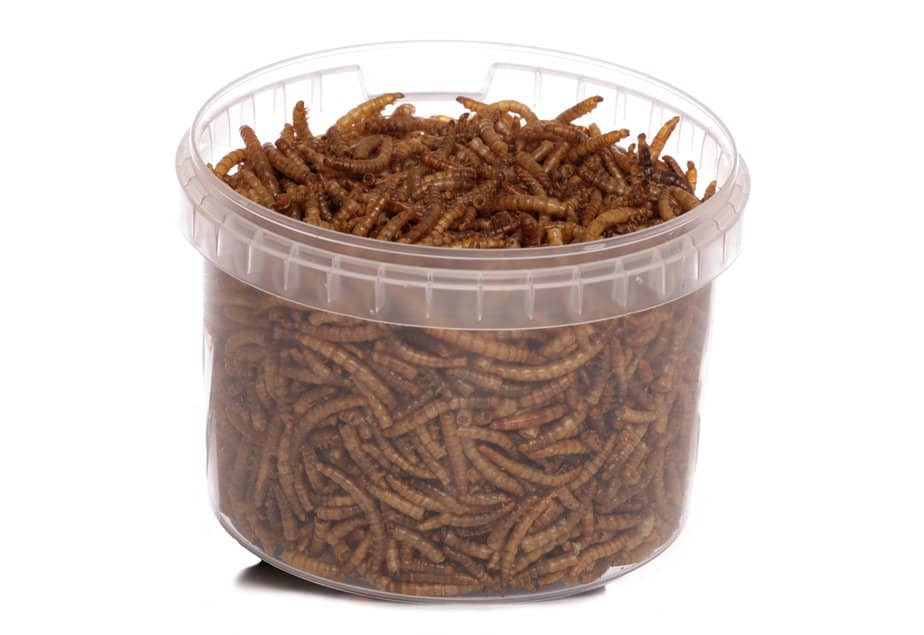Deciding what to feed these geckos can be difficult for a first-time reptile owner, especially if you’ve never handled worms before. So if you’re wondering whether your leopard gecko can eat dried mealworms, we’ve got you covered.
Leopard geckos can eat dried mealworms. However, it’s best not to feed them too often. Since dried mealworms are dead and immobile, leopard geckos don’t find them interesting and may refuse to eat them altogether.

What are mealworms?
Mealworms are the larval form of the flour beetle – also known as the mealworm beetle or Tenebrio Molitor in Latin. This insect belongs to the same order as ladybugs – Coleoptera.
Remember that mealworms measure around 2cm long and are usually brown or white. But they are only white for the 9 to 20 times they molt.
Also, they can be found worldwide and are considered pests, particularly because they feed on grain.
On the flip side, they are an excellent food for reptiles, amphibians, and birds, particularly because of their high protein content. While they are commonly fed to these animals when alive, they can also be served dried or canned.
What is the difference between dried and canned mealworms?
Dried mealworms are simply dead mealworms that have been dried through heating or freezing. As such, they have a considerably lower moisture content than live mealworms.
On the other hand, canned mealworms are made from cooking live mealworms while they are inside a can. Depending on the size of the mealworms, a single can contain 30 to 60 of them.
While the canning process results in dead mealworms, they are usually fresher than dried ones. Also, they contain more moisture and are softer, making them easier to digest.
Ultimately, their higher moisture content can be attributed to the fact that the cans they are housed in contain natural juices. It’s therefore not surprising that some canned mealworms smell bad once you open them. These juices also contribute to a short shelf life upon opening.
As such, it’s advisable to refrigerate canned mealworms once you open them. But even then, expect them to last only 3 to 10 days.
On the other hand, you can keep dried mealworms for up to 2 years as long as you store them in an airtight container in a cool, dry place. You can even use a sealed bag for this.
What are the advantages of feeding your leopard gecko dried mealworms?
Here are the top advantages of feeding your leopard gecko dried mealworms:
Convenient
Since dried mealworms are easy to store and serve, they can be a great option when you’re busy. After all, you don’t need to gut load them – dust them in vitamin D3 and calcium supplements and then offer them to your gecko.
No opportunity for escape
Since dried mealworms can’t move, they can’t escape from your leopard gecko.
What are the cons of feeding your leopard gecko dried mealworms?
The top 3 cons of feeding your leopard gecko dried mealworms are:
Low moisture content
Dried mealworms have a lower moisture content than both live and canned ones. While dried mealworms only contain 5% of moisture, live and canned ones contain 62% and 68%, respectively.
This means that they are more difficult to swallow and digest. Frequently feeding them to your leopard gecko can easily lead to impaction.
Ultimately, dried mealworms should only be offered as occasional treats to adult leopard geckos and avoided entirely for babies.
High fat content
If there’s one thing that dried mealworms have going for them, it’s that they have more protein (53%) than live (20.3%) and canned (17.9%) ones.
However, they also contain a lot more fat, meaning that they can easily make your leopard gecko obese if you offer them frequently.
Dried mealworms contain more than double of fat present in live ones – the former stands at 28% while the latter stands at 13%. On the other hand, canned mealworms have a 5.9% fat content.
Not engaging
The most noticeable disadvantage of feeding your leopard gecko dried mealworms is that they are not engaging prey.
As such, they won’t help your leopard gecko hone their hunting skills or stay active mentally and physically.
In fact, many leopard geckos will find these dead prey undesirable – you may have to use a vibrating dish to lure them in.
However, keep in mind that live mealworms aren’t that fast either.
How to feed dried mealworms to your leopard gecko?
If you choose to feed your adult leopard gecko dried mealworms, try to offer only a few every other week.
If circumstances force you to offer these worms more often, ensure that your gecko has access to ample water so that they don’t get dehydrated or impacted.
Also, remember to dust the dried mealworms with supplements and check them for bacterial/mold growth beforehand. A single patch of mold or bacteria is a valid reason to throw out the dried mealworms immediately.
Can you store dried mealworms in your refrigerator?
While dried mealworms require low temperatures to last long, placing them in the refrigerator or freezer isn’t a good idea. It can easily lead to moisture accumulation and bacteria or mold growth.
Where can you buy dried mealworms?
Dried mealworms are readily available in online and offline pet and pet feed stores. You can even find them at retail stores like Walmart.
Although you source your dried mealworms, they are usually affordable.
Final thoughts
When it comes down to it, it’s better to feed your leopard gecko live mealworms than dried ones.
This usually applies to all types of leopard gecko food. So if you ever have to choose between dried mealworms and live crickets or any other live insect, always go for the latter!
